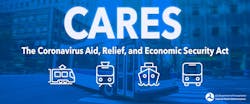FTA announces $25B to help public transportation systems respond to COVID-19
The Federal Transit Administration (FTA) today announced $25 billion in federal funding allocations to help the nation’s public transportation systems respond to the ongoing coronavirus (COVID-19) pandemic.
Funding is provided through the Coronavirus Aid, Relief, and Economic Security (CARES) Act, signed by President Trump on March 27.
FTA says it is allocating $25 billion to recipients of urbanized area and rural area formula funds, with $22.7 billion allocated to large and small urban areas and $2.2 billion allocated to rural areas. Funding will be provided at a 100% federal share, with no local match required, and will be available to support capital, operating, and other expenses generally eligible under those programs to prevent, prepare for, and respond to COVID-19.
Further, operating expenses incurred beginning on January 20, 2020 for all rural and urban recipients, even those in large urban areas, are also eligible, including operating expenses to maintain transit services as well as paying for administrative leave for transit personnel due to reduced operations during an emergency.
"We know that many of our nation’s public transportation systems are facing extraordinary challenges, and these funds will go a long way to assisting our transit industry partners in battling COVID-19," FTA Acting Administrator K. Jane Williams said in a statement. "These federal funds will support operating assistance to transit agencies, including those in large urban areas as well as pay transit workers across the country not working because of the public health emergency."
In addition to the $25 billion funding allocation announced today, FTA has taken other steps to support the transit industry during this public health emergency, including expanding the eligibility of federal assistance available under FTA’s Emergency Relief Program to help transit agencies respond to COVID-19 in states where the governor has declared an emergency.
Additionally, FTA recently announced that it would provide a 30-day extension of the deadline for current competitive grant program funding opportunities.
-------
SOURCE: Federal Transit Administration
